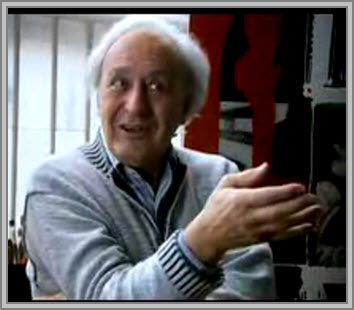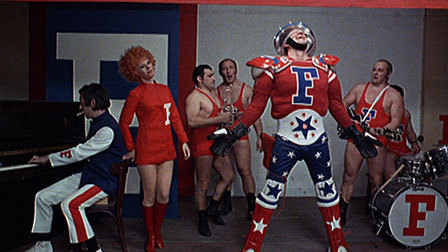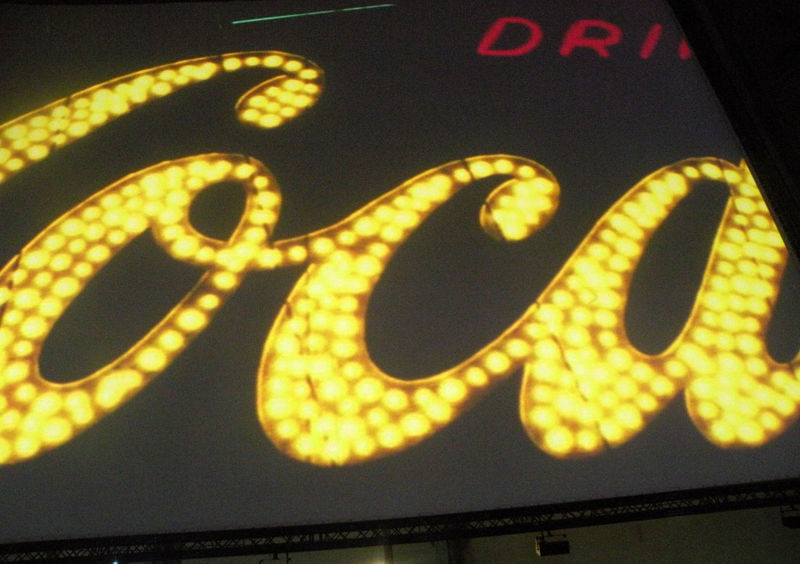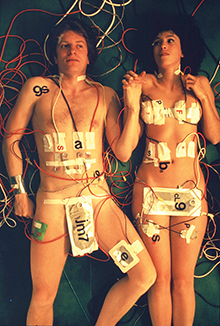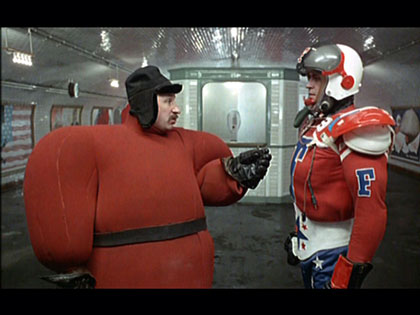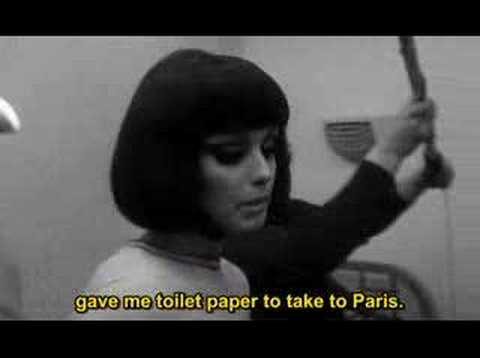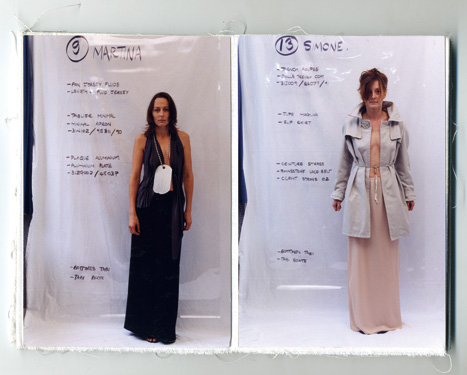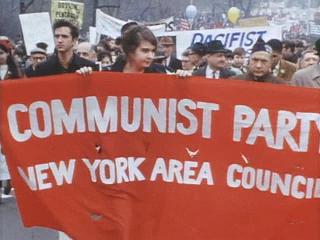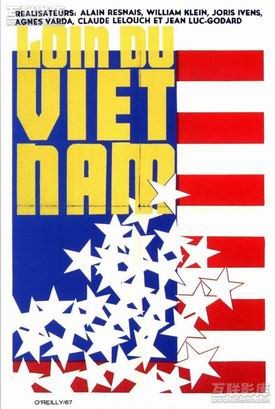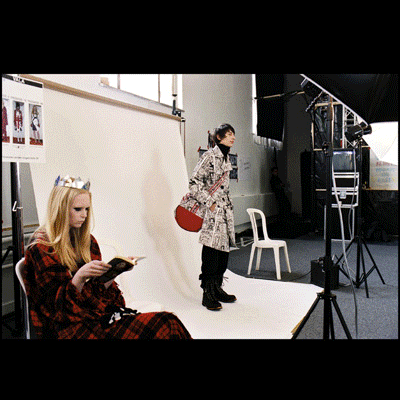This appeared in the December 8, 1989 issue of the Chicago Reader. –J.R.
THE FILMS OF WILLIAM KLEIN
At a time when the National Endowment for the Arts is under siege — and not only from yahoos like Jesse Helms, but also from certain anarchists, leftists, and intellectuals — the general paucity of information and understanding about national funding of the arts in other countries only helps to underline how isolationist this country has become in cultural matters. As a rule, our overseas news coverage and our access to foreign films both seem to operate according to the same chillingly reductive circular reasoning: if people don’t already know about something or understand it, they aren’t likely to be interested.
Thus reports last spring of the demonstrations in Tiananmen Square routinely assumed that any popular sentiments in China that didn’t support the status quo automatically had to be “pro-democracy”; a lifetime of U.S. reporting has been devoted to the principle that only two political positions exist in the world, not three or six or 30 or 600. By the same token, most of the foreign films that we wind up seeing are those that support rather than challenge our generally clichéd notions of what other countries are like. (The same thing holds for American pictures about foreign countries: the scaling down of Milan Kundera’s The Unbearable Lightness of Being for the screen, widely praised by several U.S. critics, heavily emphasized what the American public already knew, or thought it knew, about Czechoslovakia, and pared away most of the rest — including, for instance, Kundera’s provocative view of the U.S.)
Returning to the question of state funding of the arts, it’s worth pointing out a couple of salient facts that have been commonly overlooked in most of the recent debates about the NEA: (1) our government is already substantially less supportive of art and artists than those of most other countries in the world, and (2) the most aesthetically and socially progressive film work coming out of Europe, and much of the best independent work coming from the U.S. — I’m thinking of works by Chantal Akerman, Robert Bresson, Terence Davies, Jean-Luc Godard, Peter Greenaway, Joris Ivens and Marceline Loridan, Derek Jarman, Jon Jost, Krzysztof Kieslowski, Chris Marker, Yvonne Rainer, Mark Rappaport, Jacques Rivette, and Raul Ruiz, among many others — would not exist without some form of European state support.
A simple comparison of what the American Film Institute does with what the British Film Institute does (with much less money) is staggering, particularly if one contrasts the more commercial and national interests of the former with the less commercial and more international interests of the latter. A few years ago, when the BFI was celebrating its 50th anniversary, I proposed writing an objective description of its activities for American Film, the AFI’s house organ; the editor at the time replied regretfully that such a piece would be much too controversial for him to consider.
All this is a preamble to considering the work of William Klein, an American who has lived in France since the late 1940s. Most of his films would not exist without the support of European grant-giving agencies (including European TV), and none of them would be available to us without the NEA — which enabled the Walker Art Center to mount a nationally touring retrospective, an abbreviated version of which is currently showing at the Film Center. I don’t want to argue in this case that Klein’s films are as important as those of contemporary masters of French cinema such as Marker, Godard, or Rivette, but they’re fascinating, singular, and at times even exciting works that tell us all sorts of things about both France and the U.S. as seen from abroad that we’d never find in commercial releases. The nearly total neglect that they’ve received prior to this retrospective tells us a great deal about how much our film culture is delimited by restrictive categories — how much gets factored out of consideration merely because it eludes those categories.
William Klein was born in New York City in 1928 and entered City College of New York, where he majored in sociology, when he was 14. After serving in the U.S. Army during the occupation of Germany in the mid-1940s, where he won his first still camera (a Rolleiflex) in a poker game, he spent his second year of service in France and studied at the Sorbonne. Afterward, he made Paris his permanent home and studied painting with Fernand Léger.
By the early 50s, his interest had shifted from painting to still photography, and he became a photographer for American Vogue while working on a book-length photographic study of New York, which was published by Chris Marker at Éditions de Seuil in 1956. This led to a series of additional photographic books devoted to major cities — Rome (1958), Moscow (1959), and Tokyo (1961) — as well as some early forays into film: a striking, quasi-abstract color 35-millimeter short called Broadway by Light (1958), which Orson Welles praised as the first film he’d seen in which the color was absolutely necessary; another short called How to Kill a Cadillac (1959); and work as a creative consultant on the visual design of Louis Malle’s Zazie dans le métro (1960), a comedy feature that not coincidentally happens to be the most visually impressive and distinctive of Malle’s works.
Next came Klein’s first feature-length documentary, a piece about Cassius Clay (1965) that he later revised, expanded, and updated into Muhammad Ali the Greatest (1974), one of the films showing this weekend at the Film Center. At this point he abandoned still photography to work exclusively in film and television, making three features (Qui est vous, Polly Maggoo?, 1966; Mr. Freedom, 1969; and The Model Couple, 1976); the American sequences for the collaborative antiwar feature Far From Vietnam (made with Marker, Godard, Alain Resnais, and Agnès Varda) in 1967; and several more documentaries, including Panafrican Cultural Festival (1969), Eldridge Cleaver, Black Panther (1970), Maydays (1978), and a number of works for French and German television — including The Little Richard Story (1980), which is also showing at the Film Center this weekend.
More recently, in the 80s, Klein has returned to photography and had several major exhibitions (in New York, Paris, Tokyo, Lausanne, and San Diego), made another feature (Mode in France, showing next week at the Film Center), and done a few more documentaries (including The French, also showing next week, which I haven’t seen). In addition to all his other activities, Klein has directed over 200 TV commercials, and the satirical edge in his serious work derives in part from having worked so long and hard on projects that he disliked (which probably includes his work as a fashion photographer as well). Two of his best photographs, incidentally, were reproduced and commented on by Roland Barthes in Camera Lucida (1981).
Generally regarded by the French as an American and by the Americans as a Frenchman, Klein occupies a kind of no-man’s-land in the world of film, which has rigorously excluded him from attention. In spite of his personal, professional, and political links with certain members of the French New Wave (Marker, Resnais, Varda) you won’t find his name even mentioned in most studies of the New Wave, or of French cinema in general. Similarly, although his first documentaries are contemporaneous with the rise of cinéma vérité, he is almost never mentioned in connection with that movement either. French film critics tend to ignore his work, and it has received so little exposure elsewhere that he has remained in a critical limbo throughout his 30-year career.
Having seen about half of Klein’s 20-odd films, I can venture a few generalizations about his work as a whole. Like the films of Bert Stern (Jazz on a Summer’s Day) and Bruce Weber (Broken Noses and Let’s Get Lost), two other still photographers who turned to film, Klein’s films are primarily visual and conceptual rather than linear or narrative. Even Mr. Freedom, the best of the three features by him that I’ve seen, is limited somewhat by its several beginnings and endings; the film is lively and even explosive, but it tends to explode in several directions rather than carry the force of a cumulative narrative.
A recurring visual trait in Klein’s photographs and films is punchy, hyperbolic activity shoved directly at the viewer, which yields a conscious use of blur in the still photographs and a sense of perpetual, chaotic motion in the films, which are often shot guerrilla-style, like combat footage. Media events of various kinds — political rallies, fashion shows, sporting events, rock concerts — are the gladiatorial arenas for this kind of action, and the photographers and reporters seen in the front lines at these events, armed to the teeth with microphones and cameras, often turn out to be as important to Klein as the ostensible “stars” that they are ferociously encircling. Equally important is Klein’s use of the wide-angle lens, which affords not only a far-ranging visual field with an unusual amount of depth, but also a certain amount of expressionistic distortion in the foreground, often giving a caricatural and cartoonish emphasis to the people closest to the lens. (Documentary expressionism suggests a certain contradiction — one of the factors that makes Klein’s work seem so volatile and unstable — but, as Resnais once aptly said in reference to Mr. Freedom, “As far as I’m concerned we can never go beyond expressionism.”)
In both Muhammad Ali the Greatest and The Little Richard Story, the charismatic figures named in their titles are certainly the films’ focal points, but there is also a sense that the media circuses surrounding them define their identities as well. Both of these documentaries reflect a fascination with simulacra — impersonators, imitators, and emulators of the stars whose personalized versions of their essences throw the most salient characteristics of these semimythical figures into relief. In the second section of Muhammad Ali the Greatest, shot in Boston in November 1964 — just after Lyndon Johnson defeated Barry Goldwater at the polls, and shortly before Cassius Clay (as Ali was then known) was scheduled to fight a rematch with Sonny Liston — Klein spends some time at an acting school with students who are improvising various scenes from Clay’s life, including an interview with an NBC news correspondent. Similarly, an early sequence in The Little Richard Story is devoted to cutting between Little Richard himself, performing in the 50s, and a rehearsal in the 70s where a whole slew of Little Richard imitators are being coached in how to imitate the master. (When Little Richard decides that God has told him not to be in this movie, and he leaves Macon, Georgia, where the film is being shot, he’s hardly missed at all; his imitators have by this time all but wrested the film away from their model.)
Significantly, the major figures in Mr. Freedom — from the bullish all-American hero (John Abbey) to a sultry French spy (Delphine Seyrig) to the hero’s pop Soviet and Chinese communist adversaries, Moujik Man and Red China Man, the latter an enormous inflated dragon — are not so much characters in any normal sense as puppet-show emblems put together out of crazed media collages. (Mr. Freedom, resembling a cross between a football player and an astronaut, literally comes apart in pieces in the end, like a broken doll.) The fashion models who are the focus of Klein’s first and last features, Qui est vous, Polly Maggoo? and Mode in France, are similarly viewed for the most part as media concoctions — even though in the earlier film they’re fictional characters and in the later film a collection of 13 sketches, they’re more or less playing themselves.
Regardless of whether his films are documentaries or fiction, Klein generally combines documentary techniques with an expressionistic vision to produce a disturbing and decidedly nonhumanistic view of our world as the media see it–predatory, overbearing, and glistening with glitz and hype. Yet paradoxically, his contributions to the otherwise dated Far From Vietnam, concentrating on Norman Morrison and on two war-related marches in New York (one supporting the war, one protesting it), carry a human charge and moral challenge that are decidedly missing in the self-conscious posturings of the episodes by Godard and Resnais.
Morrison, if you recall, was the American Quaker who, following the example of several South Vietnamese Buddhist monks, burned himself alive to protest the war. Most Americans at the time, including many violent opponents of the war, considered him a madman, but Klein’s sober and nonsensational interviews with Morrison’s family and with some North Vietnamese in Hanoi (where a street was named after Morrison) suggest that his act was an utterly serious and extreme form of protest. Another sequence focuses on a bearded demonstrator who repeatedly screams the word “napalm” as a sort of mantra — again, an act that many regard as demented (the ravings of a lunatic), except that Klein also films the same man’s reasonable and measured responses to people on the street who question him about what he is doing: he explains that he is drawing attention to an extreme and inhumane new form of warfare. In both cases, Klein has the resourcefulness and imagination to dig under a seemingly deranged form of protest against the war in order to show the human and rational processes underlying it.
In most of his other films, however, he is doing quite the reverse — showing media events that we normally assume to be sane and human, and unsettling us with their insane, dehumanized aspects. In both cases, one might say that this is merely doing what a good reporter should do — bearing witness to his times in a way that reveals the subtexts that other journalists overlook. But these pieces don’t allow us any snug sense of closure (the kind of satisfaction that a well-told story usually affords), the feeling that we can walk away from the subjects with the illusion of having mastered and fully understood them. They throw us into the thick of things and make us scramble, teasing us with the very notion of authority about anyone’s identity. The title Qui est vous [Who Are You], Polly Maggoo? is emblematic, because the same sort of question is being asked of Muhammad Ali, Eldridge Cleaver, Little Richard — or anyone else who happens to be the target of Klein’s camera. (If Mr. Freedom breaks with this pattern somewhat and gives one a feeling of completeness, this may be because conceivably no other film of the 60s confronts the specter of the Ugly American so thoroughly and with such comic venom; Klein vents his rage against this emblem with the virulence of a William Burroughs.)
One of the curious differences between Qui est vous, Polly Maggoo? (regrettably missing from the Film Center’s retrospective) and Mode in France–two satirical treatments of the Parisian world of high fashion made about 20 years apart — is how airy and international in spirit the former is, and how claustrophobic and insulated the latter turns out to be. Part of this undoubtedly has something to do with the differences between the 60s and the 80s: Polly Maggoo is roughly contemporary with A Hard Day’s Night and The Knack (two Richard Lester films with similar high-contrast black- and-white cinematography and frenetic editing), as well as John Schlesinger’s Darling and Godard’s Masculin-féminin, which provide other useful cross-references. All five of these films reflect a period of youthful energies when fashion and word-of-mouth news traveled both farther and faster than they do today.
Mode in France, by contrast, despite the presence of Grace Jones and many other non-French models, often seems stranded in — or at least restricted to — France in the mid-80s; the forms of designer excess that it both parodies and revels in, evident in the settings as well as the outfits, are made to seem less universal. It even made me wonder whether, after 40 years of living in Paris, Klein has finally become even more French than his neighbors, and correspondingly less American.
I can’t say that I enjoyed this film as much as the others I’ve seen — the shapes of too many of the episodes seem fuzzily defined — but as a look at the cultural sensibility of France in the 80s, I must confess that though different, the film is no less valuable. We often tend to forget that we see only a thin crust of films from other countries, and, as I’ve suggested above, what we do see is usually far from characteristic. I doubt that Mode in France is a “characteristic” French film, but I strongly suspect that it is characteristically French in ways that recent movies by Malle, Varda, Claude Miller, and Claude Sautet are not. If you’d like to know what it’s like to be in France right now, this is a movie that could tell you a lot.

